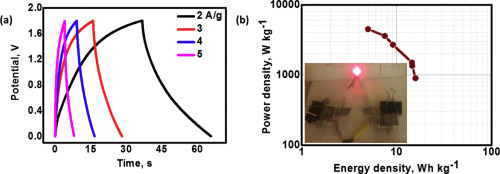当前位置:
X-MOL 学术
›
J. Electroanal. Chem.
›
论文详情
Our official English website, www.x-mol.net, welcomes your
feedback! (Note: you will need to create a separate account there.)
Mesoporous spinel manganese zinc ferrite for high-performance supercapacitors
Journal of Electroanalytical Chemistry ( IF 4.1 ) Pub Date : 2018-05-01 , DOI: 10.1016/j.jelechem.2018.04.002 Fatma M. Ismail , Mohamed Ramadan , Ahmed M. Abdellah , Ibrahim Ismail , Nageh K. Allam
Journal of Electroanalytical Chemistry ( IF 4.1 ) Pub Date : 2018-05-01 , DOI: 10.1016/j.jelechem.2018.04.002 Fatma M. Ismail , Mohamed Ramadan , Ahmed M. Abdellah , Ibrahim Ismail , Nageh K. Allam

|
Abstract We report on the synthesis of manganese zinc ferrite (MnZnFe2O4) nanoneedles via a simple one-pot coprecipitation method and their characterization using energy-dispersive spectroscopy (EDS), X-ray diffraction (XRD), field emission scanning electron microscope (FESEM), high-resolution transmission electron microscope (HR-TEM) and N2 adsorption/desorption techniques. The electrochemical performance of MnZnFe2O4 nanoneedles-based supercapacitors was investigated, showing superior specific capacitance of 783 F g−1, which is significantly higher than that reported for any ferrite material. Also, the spinel MnZnFe2O4 exhibits very high columbic efficiency and an excellent long-term stability. The fabricated asymmetric supercapacitor based on MnZnF2O4 nanoneedles/activated carbon electrodes can deliver 15.8 Wh kg−1 energy density at a power density of 899.7 W kg−1. The contribution of the double layer capacitance was found to be only 3.14% of the total specific capacitance and mainly based on psuedocapacitance faradaic mechanism. Therefore, the fabricated MnZnFe2O4 electrode is a promising candidate for supercapacitor applications.
中文翻译:

用于高性能超级电容器的介孔尖晶石锰锌铁氧体
摘要 我们报告了通过简单的一锅共沉淀法合成锰锌铁氧体 (MnZnFe2O4) 纳米针,并使用能量色散谱 (EDS)、X 射线衍射 (XRD)、场发射扫描电子显微镜 (FESEM) 对其进行表征。 、高分辨率透射电子显微镜 (HR-TEM) 和 N2 吸附/解吸技术。研究了基于 MnZnFe2O4 纳米针的超级电容器的电化学性能,显示出 783 F g-1 的优异比电容,明显高于任何铁氧体材料报道的电容。此外,尖晶石 MnZnFe2O4 表现出非常高的库伦效率和优异的长期稳定性。基于 MnZnF2O4 纳米针/活性炭电极制造的非对称超级电容器可以提供 15. 8 Wh kg-1 能量密度,功率密度为 899.7 W kg-1。发现双层电容的贡献仅占总比电容的 3.14%,主要基于伪电容法拉第机制。因此,所制造的 MnZnFe2O4 电极是超级电容器应用的有希望的候选者。
更新日期:2018-05-01
中文翻译:

用于高性能超级电容器的介孔尖晶石锰锌铁氧体
摘要 我们报告了通过简单的一锅共沉淀法合成锰锌铁氧体 (MnZnFe2O4) 纳米针,并使用能量色散谱 (EDS)、X 射线衍射 (XRD)、场发射扫描电子显微镜 (FESEM) 对其进行表征。 、高分辨率透射电子显微镜 (HR-TEM) 和 N2 吸附/解吸技术。研究了基于 MnZnFe2O4 纳米针的超级电容器的电化学性能,显示出 783 F g-1 的优异比电容,明显高于任何铁氧体材料报道的电容。此外,尖晶石 MnZnFe2O4 表现出非常高的库伦效率和优异的长期稳定性。基于 MnZnF2O4 纳米针/活性炭电极制造的非对称超级电容器可以提供 15. 8 Wh kg-1 能量密度,功率密度为 899.7 W kg-1。发现双层电容的贡献仅占总比电容的 3.14%,主要基于伪电容法拉第机制。因此,所制造的 MnZnFe2O4 电极是超级电容器应用的有希望的候选者。











































 京公网安备 11010802027423号
京公网安备 11010802027423号